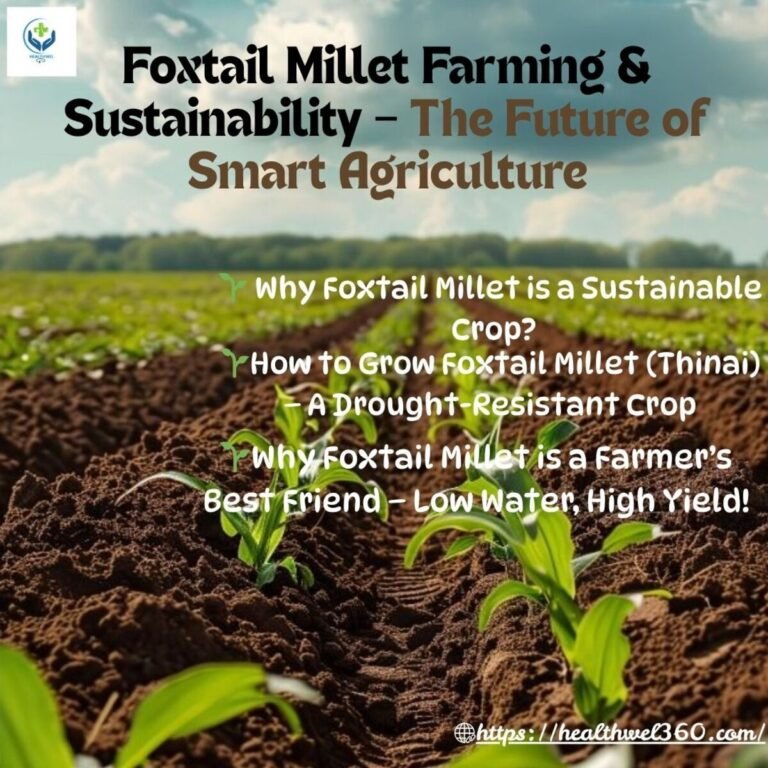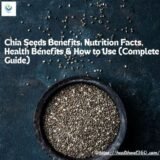Foxtail Millet Farming & Sustainability. Foxtail Millet Farming & Sustainability – The Future of Smart Agriculture. “Foxtail millet (Setaria italica), known as Thinai in Tamil, is not just a nutrient-dense grain—it’s also one of the most climate-resilient and sustainable crops for modern farming. With rising concerns over water scarcity and soil degradation, foxtail millet offers a low-input, high-yield solution for farmers and eco-conscious consumers.
Here’s why foxtail millet farming is a game-changer for sustainable agriculture, along with practical cultivation tips!
🌱 Why Foxtail Millet is a Sustainable Crop?
- Drought-Resistant & Water-Efficient
- Requires only 1/3 the water of rice or wheat.
- Grows well in low-rainfall regions (as little as 400mm annually).
- Short Growth Cycle
- Matures in 65-75 days (vs. 120+ days for rice).
- Allows 2-3 crop rotations per year, maximizing land use.
- Soil Health Booster
- Because deep roots link soil, they minimise runoff.
- Improves fertility – Adds organic matter when used as green manure.
- Low Carbon Footprint
- Minimal need for chemical fertilizers/pesticides.
- Carbon-sequestering crop – Absorbs CO₂ efficiently.
- Economic Benefits for Farmers
- Low production cost (fewer inputs needed).
- High market demand as a “superfood” in urban markets.
How to Grow Foxtail Millet (Thinai) – A Drought-Resistant Crop
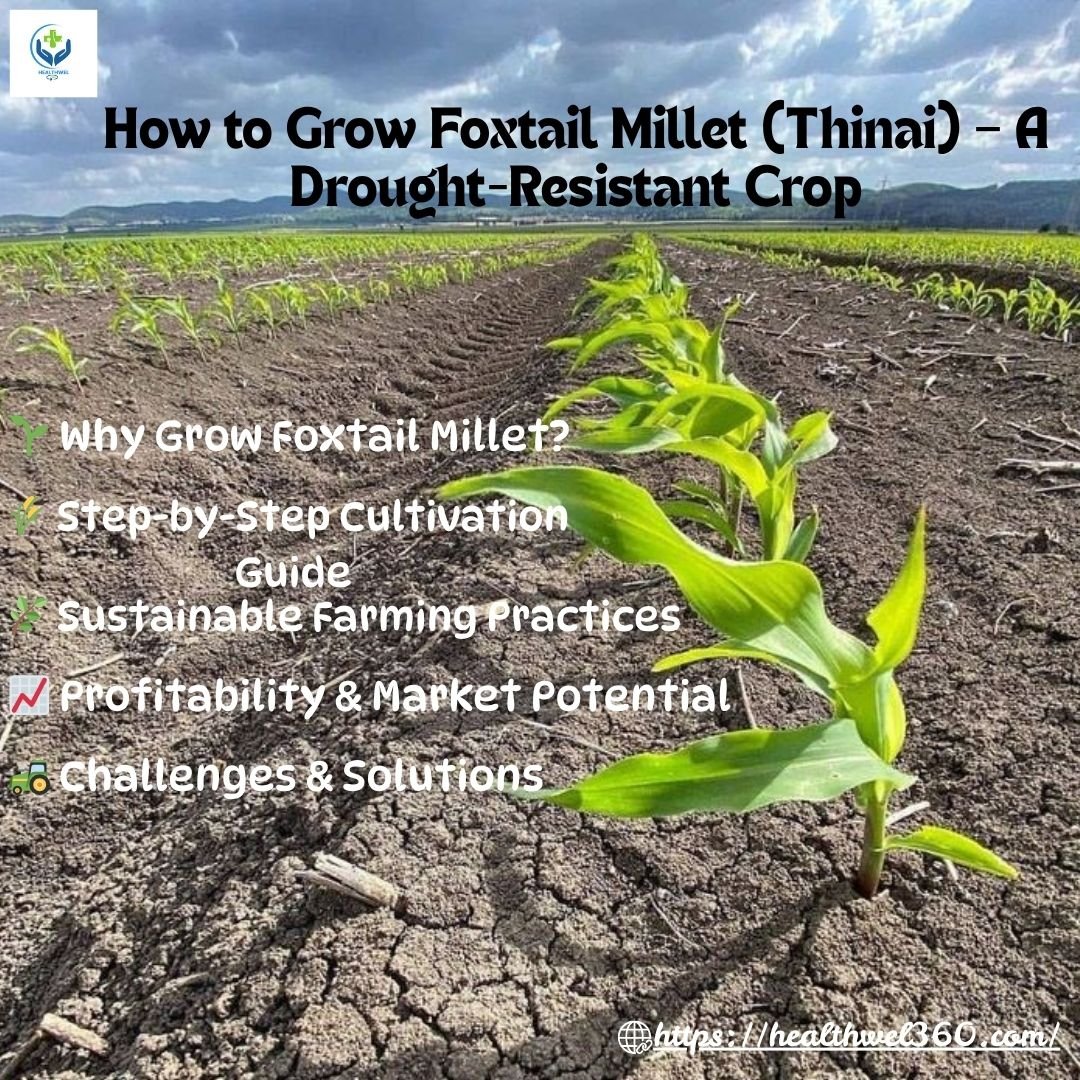
Foxtail millet (Setaria italica), known as Thinai in Tamil, is one of the oldest cultivated grains and a farmer’s best friend in dry regions. With its minimal water needs, short growth cycle, and high nutritional value, it’s an ideal crop for climate-resilient farming.
Whether you’re a small-scale farmer or a home gardener, here’s a step-by-step guide to growing foxtail millet successfully—from seed selection to harvest!
🌱 Why Grow Foxtail Millet?
✅ Adaptable to dry conditions: grows on just between 300 and 400 mm of annual precipitation
✅ Fast-growing – Ready in 65-75 days (vs. 120+ days for rice/wheat)
✅ Soil-friendly – Improves fertility, prevents erosion
✅ Low-cost farming – Needs minimal fertilizers/pesticides
✅ High demand – Rising popularity as a nutritious superfood
🌾 Step-by-Step Cultivation Guide
- Climate & Soil Requirements
- Best climate: Warm & dry (20-30°C). Grows well in semi-arid regions.
- Soil type: Well-drained sandy loam or loamy soil (pH 5-8).
- Avoid: Waterlogged or highly acidic soils.
- Land Preparation
- To break up clods, plough the land two or three times.
- Apply compost or FYM (Farm Yard Manure) @ 4-5 tons/acre for organic farming.
- To avoid water stagnation, make sure the drainage is adequate.
- Seed Selection & Sowing
- Best varieties:
- Traditional: SiA 3088, SiA 3156 (high-yielding).
- Hybrids: PR 202, HMT 100-1 (disease-resistant).
- Seed rate: 8-10 kg/acre (for broadcasting).
- Sowing methods:
- Spreading (conventional): Lightly scrape the soil and distribute seeds evenly.
- Line sowing (modern) – Space rows 25-30 cm apart, seeds 2-3 cm deep.
- Best time to sow:
- Kharif season (June-July with monsoon rains).
- Summer (Feb-March with irrigation).
- Irrigation Management
- Rainfed farming: Needs only 2-3 irrigations (if rain fails).
- Critical stages for watering:
- Germination (if soil is dry).
- Flowering & grain-filling (boosts yield).
- Drip irrigation (optional) – Saves 30-40% water.
- Weed & Pest Control
- Weeding:
- First weeding at 15-20 days after sowing.
- Second weeding (if needed) at 35-40 days.
- Common pests & organic solutions:
- Shoot fly – Neem oil spray.
- Birds – Scarecrows/nets during grain maturity.
- Fertilization (Optional)
- Organic: Apply vermicompost or jeevamrutham.
- Chemical (if needed):
- Basal dose: 40:20:20 kg/acre (NPK).
- Top dressing: 20 kg N/acre at tillering stage.
- Harvesting (65-75 Days After Sowing)
- Signs of maturity:
- Stems turn yellowish-brown.
- Grains are hard & dry (bite test).
- Harvest method:
- Manual: Cut panicles with sickles, dry for 2-3 days, thresh.
- Machine: Small millet threshers save labor.
- Yield:
- Rainfed: 600-800 kg/acre.
- Irrigated: Up to 1-1.2 tons/acre.
🌿 Sustainable Farming Practices
- Overlapping: To fix oxygen, grow pulses like cowpeas and green grammes.
- Crop rotation: Alternate with vegetables or legumes to break pest cycles.
- Covering: To keep the soil wet, use grass.
- Seed saving: Preserve traditional landraces for future planting.
📈 Profitability & Market Potential
- Low input cost: ₹5,000-7,000/acre (vs. ₹15,000+ for paddy).
- Selling options:
- Local markets (as whole grain).
- Health food brands (for millet flour, snacks).
- Government schemes (MSP procurement in some states).
🚜 Challenges & Solutions
| Challenge | Solution |
| Bird damage at harvest | Use nets/scarecrows |
| Lack of processing machines | Invest in small millet dehullers |
| Low awareness among farmers | Join FPOs/millet promotion schemes |
Why Foxtail Millet is a Farmer’s Best Friend – Low Water, High Yield!
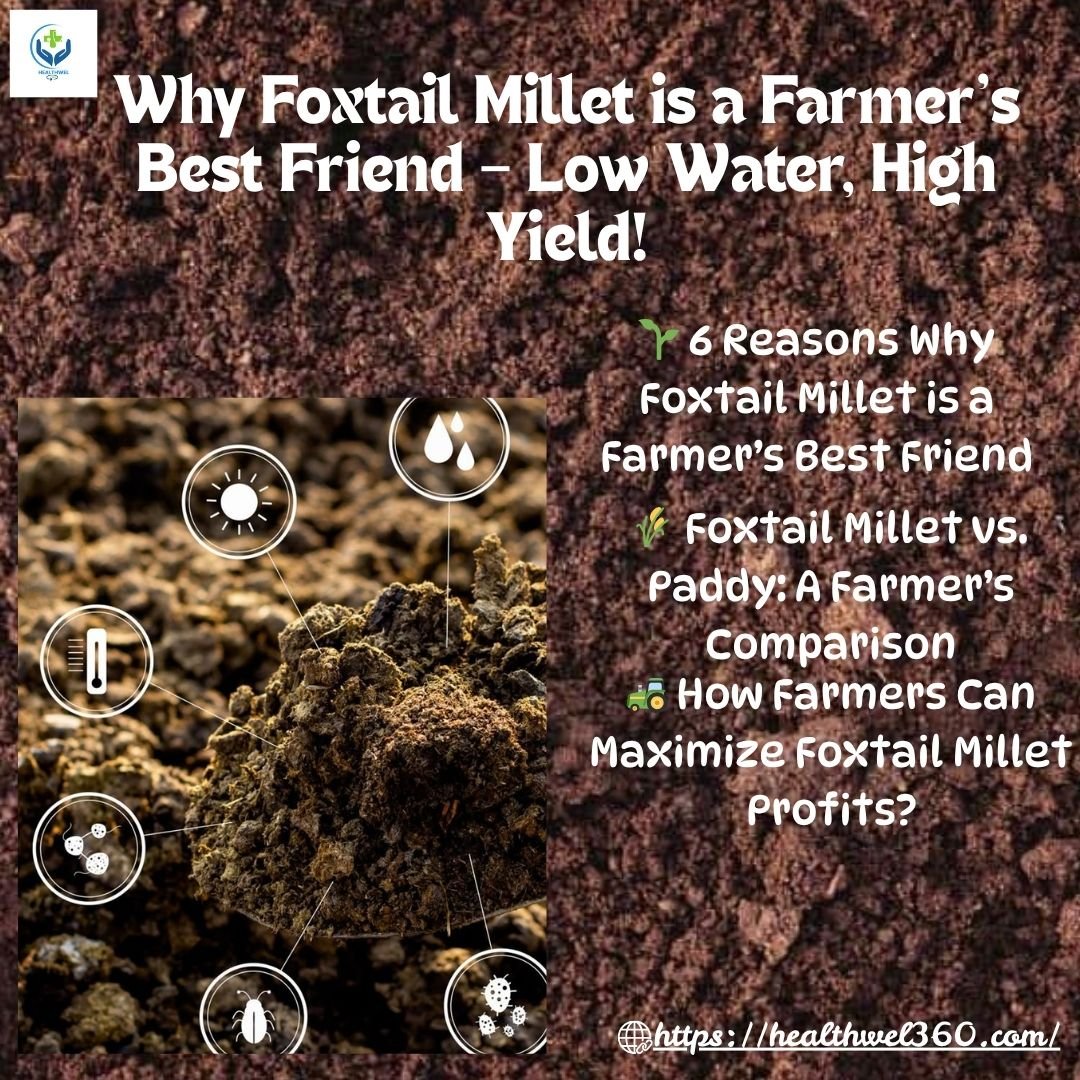
In an era of climate uncertainty and water scarcity, foxtail millet (Thinai) emerges as a hero crop for farmers. This ancient grain requires minimal inputs but delivers maximum returns, making it the perfect choice for sustainable and profitable agriculture.
Here’s why foxtail millet should be every farmer’s top pick—from its drought resistance to its high market demand!
🌱 6 Reasons Why Foxtail Millet is a Farmer’s Best Friend
- Thrives with Minimal Water
💧 Requires only 1/3 the water of rice or wheat.
💧 Grows well in low rainfall (300-400mm/year)—ideal for dryland farming.
💧 No flooding needed, unlike paddy.
- Short Growth Cycle = Faster Profits
⏳ Ready in just 65-75 days (vs. 120+ days for rice).
⏳ Allows 2-3 crops per year in rotation with pulses/vegetables.
- Grows in Poor Soil Conditions
🌱 accepts soils that are sandy or loamy and more or less fertile.
🌱 Improves soil health by preventing erosion & adding organic matter.
- Low-Cost Farming (Minimal Inputs Needed)
💰 No expensive fertilizers—responds well to compost/FYM.
💰 Few pest attacks—reduces pesticide costs.
💰 Saves electricity (no heavy irrigation pumps required).
- High Market Demand & Profitability
📈 Rising demand as a nutritious superfood in urban markets.
📈 Sells at premium prices (₹40-80/kg for organic millet).
📈 Supported by government schemes (e.g., MSP in some states).
- Climate-Smart & Future-Proof
🌍 Withstands heatwaves & erratic rainfall.
🌍 Carbon-friendly crop—absorbs CO₂ efficiently.
🌾 Foxtail Millet vs. Paddy: A Farmer’s Comparison
| Factor | Foxtail Millet | Paddy (Rice) |
| Water Needed | 300-400mm (rainfed) | 1500-2000mm (flooding) |
| Growth Period | 65-75 days | 120-150 days |
| Input Cost/Acre | ₹5,000-7,000 | ₹15,000-20,000 |
| Profit Potential | ₹25,000-40,000/acre | ₹20,000-30,000/acre |
🚜 How Farmers Can Maximize Foxtail Millet Profits?
- Adopt Smart Farming Practices
✅ Intercropping – Grow with pulses (green gram) for extra income.
✅ Organic farming – Certified organic millet sells 2-3x higher.
✅ Drip irrigation (if possible) – Saves 30% more water.
- Tap into Growing Markets
🛒 Sell to health food brands (for millet flour, snacks).
🛒 Supply government mid-day meal schemes (millet now included).
🛒 Export opportunities (Europe/US health food markets).
- Use Government Support
🏛️ Subsidies for millet processing units (e.g., dehullers).
🏛️ MSP purchasing in countries such as Odisha and Karnataka.
🏛️ Training programs by KVKs & agriculture departments.
🌍 Real-Life Success Stories
- Ramesh (Andhra Pradesh): Switched from cotton to millet, cut water use by 60%, doubled profits.
- Priya (Tamil Nadu): Runs a women’s millet FPO, sells value-added products (cookies, flakes).
Sustainable Farming with Foxtail Millet – The Future of Smart Agriculture
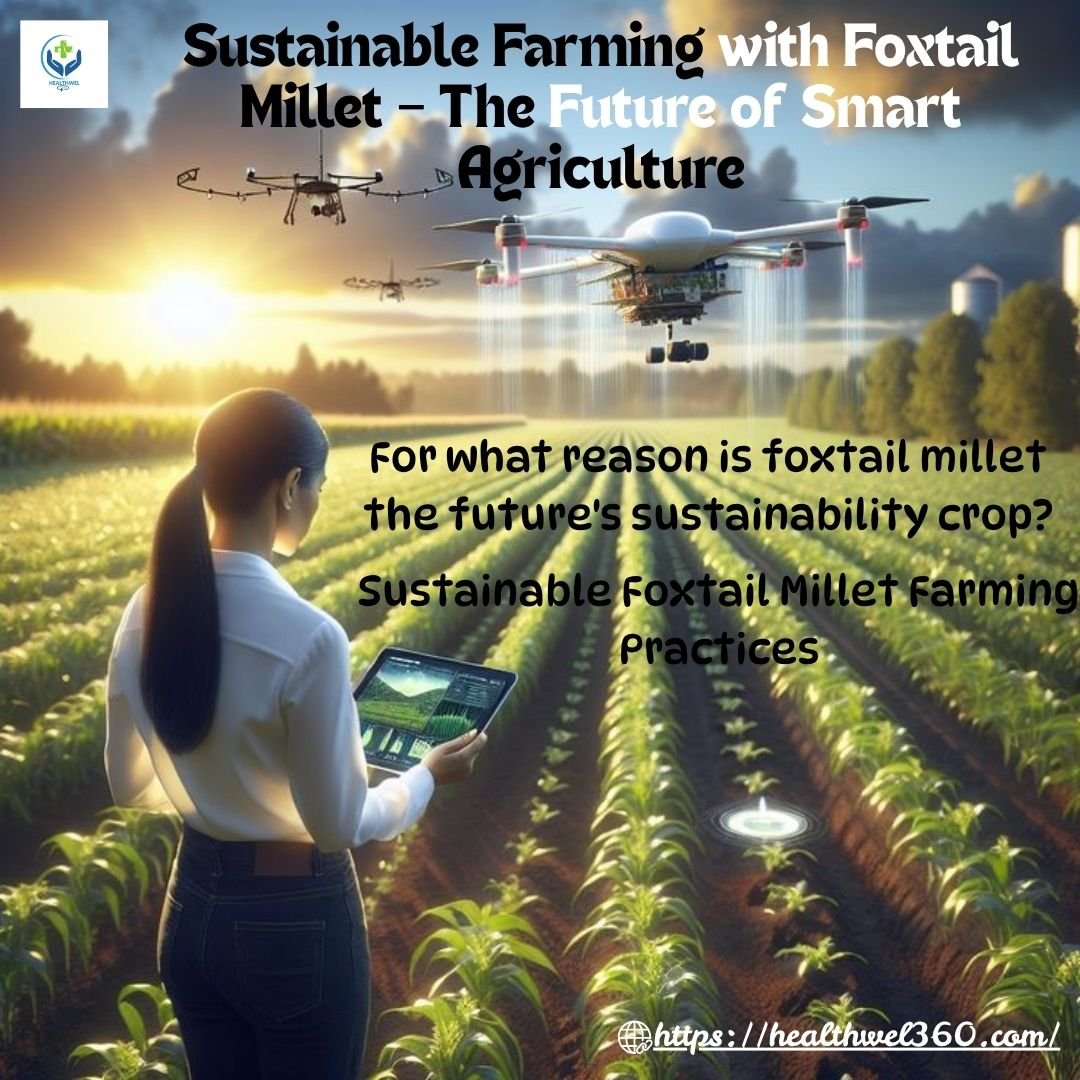
As climate change reshapes global agriculture, foxtail millet (Thinai) emerges as a superhero grain for sustainable farming. This ancient crop, cultivated for over 5,000 years, offers climate resilience, water efficiency, and exceptional nutrition – making it the perfect solution for tomorrow’s farms.
For what reason is foxtail millet the future’s sustainability crop?
- Unmatched Drought Resistance
- Thrives on just 300-400mm annual rainfall (1/3 of rice’s requirement)
- Deep root system (up to 1.8m) accesses subsoil moisture
- Survives 40+°C temperatures where other crops fail
- Water Conservation Champion
- Requires 70% less irrigation than wheat/rice
- Grows successfully in rainfed conditions
- Ideal for regions with high water levels such as Maharashtra and Rajasthan
- Soil Regeneration Power
- Improves soil structure through extensive root networks
- Then employed as green compost, adds biological material.
- Prevents erosion in degraded lands
- Climate-Smart Superfood
- Carbon-negative crop: Absorbs more CO₂ than emitted
- Zero methane (unlike flooded rice paddies)
- Short 65-75 day growing season fits changing weather patterns
Sustainable Foxtail Millet Farming Practices
- Organic Cultivation Methods
- Natural pest resistance reduces chemical needs
- Instead of artificial fertilisers, it thrives on manure and FYM.
- It is perfect for zero-budget natural farming (ZBNF) systems.
- Smart Crop Rotations
- After rice: Breaks pest cycles, conserves water
- With pulses: Natural nitrogen fixation
- Before vegetables: Improves subsequent crop yields
- Water-Saving Techniques
- Dry sowing before monsoon arrival
- Using crop residue as mulch to keep wetness in
- Drip irrigation for critical growth stages
Economic & Environmental Benefits
| Aspect | Foxtail Millet | Conventional Crops |
| Water Use | 2,500 l/kg | 5,000+ l/kg (rice) |
| Growing Days | 65-75 | 120-150 (wheat) |
| Input Costs | ₹5,000/acre | ₹15,000+/acre |
| Carbon Footprint | 0.3 kg CO₂/kg | 1.2 kg CO₂/kg (rice) |
Success Stories
- Andhra Pradesh: 5,000+ farmers switched to millets, saving 60% water
- Karnataka: FPOs achieving 200% profit margins with value-added products
- Tamil Nadu: In areas vulnerable to flooding, classical Thinai planting is being reintroduced
The Way Forward
- Government Support: Expand millet MSP and procurement
- Consumer Awareness: Promote as climate-friendly superfood
- Research Investment: Develop high-yielding, climate-resilient varieties
Join the millet revolution! Every acre of foxtail millet grown:
- Saves 1 million liters of water
- Reduces agricultural emissions
- Provides nutrient-dense food
“Foxtail millet is more than an agricultural product – it’s an environmental option with long roots in our history and an essential function in the years to come.”

